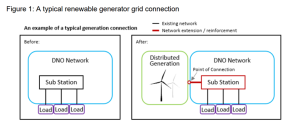The electricity network comprises two linked systems: transmission and distribution.
Electricity transmission transports electricity over long distances across the country at a high voltage to reduce losses. The transmission network includes network at 400kV, 275kV, and (in Scotland) 132kV, and is owned and operated by the Transmission Owners (TOs). Electricity distribution takes power from the transmission network and distributes it to consumers. The voltage is reduced to the correct supply voltage for the loads. In England and Wales, these networks operate at 132kV and below. Most residential customers are supplied at 230V, whilst some larger consumers may have a 3-phase 415V supply or higher. These networks are owned and operated by licenced Distribution Network Operators (DNOs – Scottish and Southern Energy Networks and Scottish Power Energy Networks) who are each responsible for the network within a geographic area.
In a traditional power system, large power stations feed into the transmission network, and the electricity is then transported to the distribution networks. The distribution networks carry the electricity to loads, such as homes and businesses. However, increasing numbers of distributed generators are connecting directly to the distribution network.
Any community that is considering installing a renewable energy scheme is likely to connect to the distribution network, rather than the transmission network. Therefore, the DNO will be the main point of contact for connection. In Figure 1, the generation is connected to the DNO network via a (hopefully short) network extension, and the local substation may need to be reinforced (for example, with a larger transformer). Note that in some cases, equipment further up the network may also need to be reinforced.

A number of technical standards govern the requirements for grid connection. These standards serve several purposes, including:
- to ensure that the generator will be able to operate safely on the network, and will not cause any issues with network protection or power quality (such as voltage level and frequency), and
- to protect the generator from any faults that may occur on the distribution network.
The processes used for connection of embedded generation depend on the size of electricity generator and falls under two sets of Engineering Recommendations (EREC); G98 and G99. For further details on this and further information on applying for a grid connection, please refer to the grid connection module.